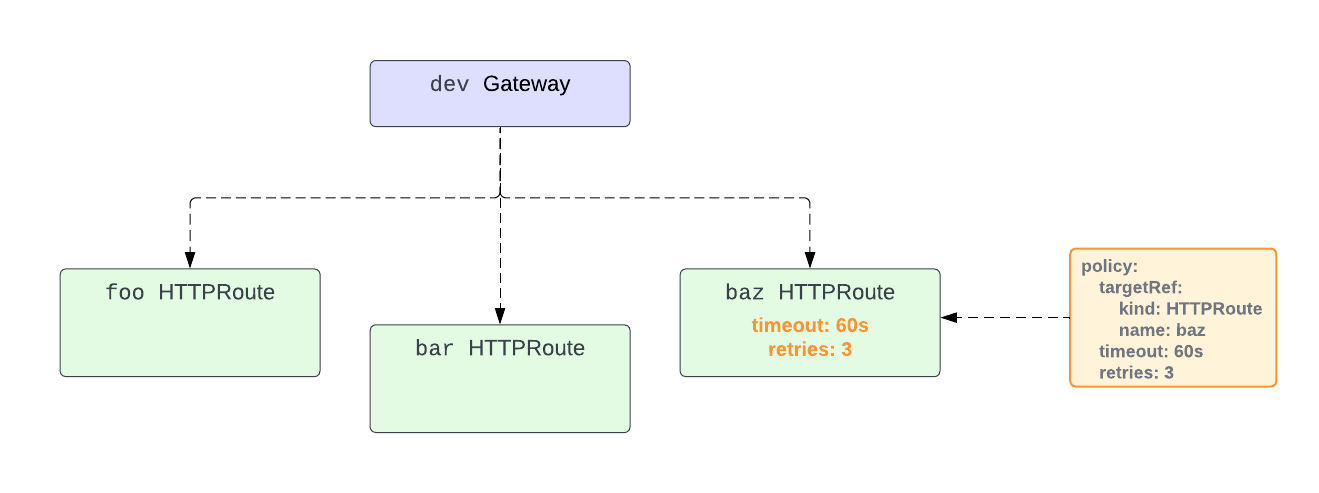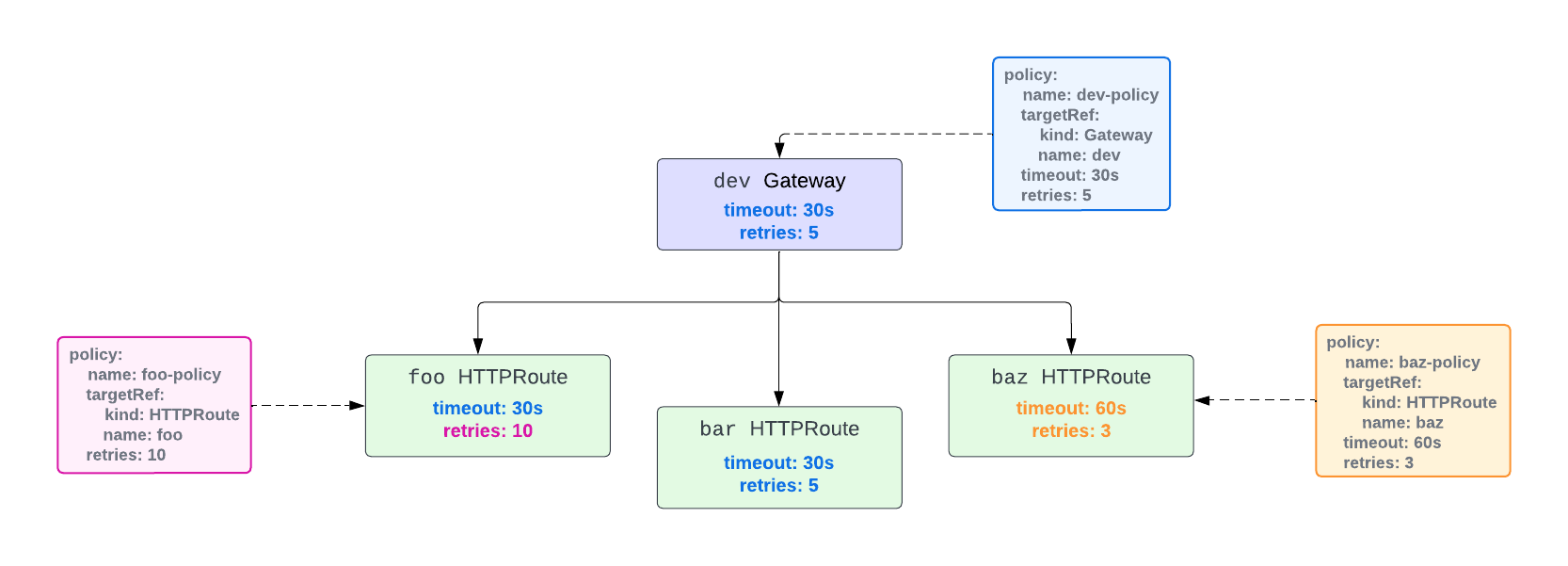Custom policies
Custom policies are NGINX Gateway Fabric CRDs (Custom Resource Definitions) that allow users to configure NGINX data plane features that are unavailable in the Gateway API. These custom policies follow the Gateway API Policy Attachment pattern, which allows users to extend the Gateway API functionality by creating implementation-specific policies and attaching them to Kubernetes objects such as HTTPRoutes, Gateways, and Services.
Policies are a Kubernetes object that augments the behavior of an object in a standard way. Policies can be attached to one object (Direct Policy Attachment) or objects in a hierarchy (Inherited Policy Attachment). The following table summarizes NGINX Gateway Fabric custom policies:
| Policy | Description | Attachment Type | Supported Target Object(s) | Supports Multiple Target Refs | Mergeable | API Version |
|---|---|---|---|---|---|---|
| ClientSettingsPolicy | Configure connection behavior between client and NGINX | Inherited | Gateway, HTTPRoute, GRPCRoute | No | Yes | v1alpha1 |
| ObservabilityPolicy | Define settings related to tracing, metrics, or logging | Direct | HTTPRoute, GRPCRoute | Yes | No | v1alpha2 |
| UpstreamSettingsPolicy | Configure connection behavior between NGINX and backend | Direct | Service | Yes | Yes | v1alpha1 |
ImportantIf attaching a Policy to a Route, that Route must not share a hostname:port/path combination with any other Route that is not referenced by the same Policy. If it does, the Policy will be rejected. This is because the Policy would end up affecting other Routes that it is not attached to.
- Attachment Type. How the policy attaches to an object. Attachment type can be "direct" or "inherited".
- Supported Target Object(s). API objects the policy can be applied to.
- Supports Multiple Target Refs. Whether a single policy can target multiple objects.
- Mergeable. Whether policies that target the same object can be merged.
A Direct Policy Attachment is a policy that references a single object, such as a Gateway or HTTPRoute. It is tightly bound to one instance of a particular Kind within a single Namespace or an instance of a single Kind at the cluster-scope. It affects only the object specified in its TargetRef.
This diagram uses a fictional retry policy to show how Direct Policy Attachment works:

The policy targets the HTTPRoute baz and sets retries to 3 and timeout to 60s. Since this policy is a Direct Policy Attachment, its settings are only applied to the baz HTTPRoute.
Inherited Policy Attachment allows settings to cascade down a hierarchy. The hierarchy for Gateway API resources looks like this:

Settings defined in a policy attached to an object in this hierarchy may be inherited by the resources below it. For example, the settings defined in a policy attached to a Gateway may be inherited by all the HTTPRoutes attached to that Gateway.
Settings in an Inherited Policy can be Defaults or Overrides. Defaults set the default value for something and can be overridden by policies on a lower object. Overrides cannot be overridden by lower objects. All settings in NGINX Gateway Fabric Inherited Policies are Defaults.
Default values are given precedence from the bottom up. Therefore, a policy setting attached to a Backend will have the highest precedence over the one attached to higher objects.
The following diagram shows how Inherited Policies work in NGINX Gateway Fabric using a fictional retry policy:

There are three policies defined:
dev-policythat targets thedevGatewaybaz-policythat targets thebazHTTPRoutefoo-policythat targets thefooHTTPRoute
The settings in dev-policy affect the dev Gateway and are inherited by all the HTTPRoutes attached to dev.
The baz-policy and foo-policy are attached to the baz and foo HTTPRoutes. Since HTTPRoutes are lower than Gateways in the hierarchy, the settings defined in them override those in the dev policy.
Since the foo-policy only defines the retries setting, it still inherits the timeout setting from dev-policy.
The bar HTTPRoute has no policy attached to it and inherits all the settings from dev-policy.
With some NGINX Gateway Fabric Policies, it is possible to create multiple policies that target the same resource as long as the fields in those policies do not conflict.
For example, consider the following fictional policies:
apiVersion: gateway.nginx.org/v1alpha1
kind: ExamplePolicy
metadata:
name: retries
spec:
targetRef:
group: gateway.networking.k8s.io
kind: HTTPRoute
name: foo
retries: 10apiVersion: gateway.nginx.org/v1alpha1
kind: ExamplePolicy
metadata:
name: timeout
spec:
targetRef:
kind: HTTPRoute
name: foo
timeout: 60sThe retries ExamplePolicy defines the number of retries for the foo HTTPRoute, and the timeout ExamplePolicy defines the timeout for the foo HTTPRoute.
NGINX Gateway Fabric will merge the fields defined in the policies and apply the following settings to the foo HTTPRoute:
retries: 10
timeout: 60sHowever, if both policies had the retries field set, then the policies cannot be merged. In this case, NGINX Gateway Fabric will choose which policy to configure based on the following criteria (continuing on ties):
- The oldest policy by creation timestamp
- The policy appearing first in alphabetical order by "{namespace}/{name}"
If a policy conflicts with a configured policy, NGINX Gateway Fabric will set the policy Accepted status to false with a reason of Conflicted. See Policy Status for more details.
NGINX Gateway Fabric sets the PolicyStatus on all policies.
PolicyStatus fields:
ancestors: describes the status of a route with respect to the ancestor.ancestorRef: the object that the policy targets inspec.targetRef.controllerName: the controller name of NGINX Gateway Fabric.conditions: (Condition/Status/Reason):Accepted/True/Accepted: the policy is accepted by the ancestor.Accepted/False/Invalid: the policy is not accepted because it is semantically or syntactically invalid.Accepted/False/Conflicted: the policy is not accepted because it conflicts with another policy.Accepted/False/TargetNotFound: the policy is not accepted because it targets a resource that is invalid or does not exist.Accepted/False/NginxProxyNotSet: the policy is not accepted because it relies on the NginxProxy configuration which is missing or invalid.
To check the status of a policy, use kubectl describe. This example checks the status of the foo ObservabilityPolicy, which is accepted:
kubectl describe observabilitypolicies.gateway.nginx.org foo -n defaultStatus:
Ancestors:
Ancestor Ref:
Group: gateway.networking.k8s.io
Kind: HTTPRoute
Name: foo
Namespace: default
Conditions:
Last Transition Time: 2024-05-23T18:13:03Z
Message: Policy is accepted
Observed Generation: 1
Reason: Accepted
Status: True
Type: Accepted
Controller Name: gateway.nginx.org/nginx-gateway-controller